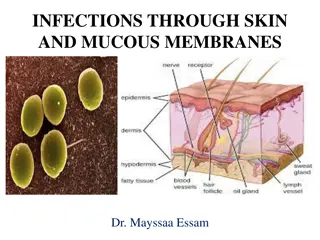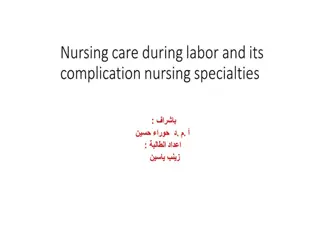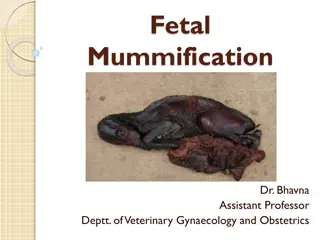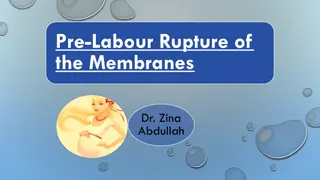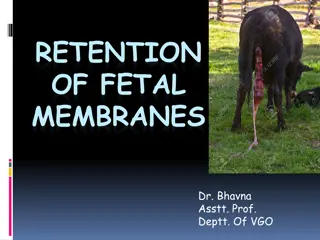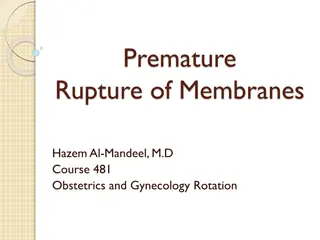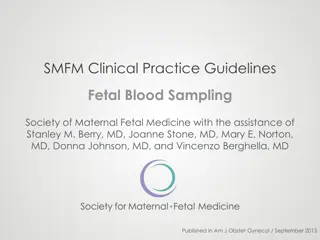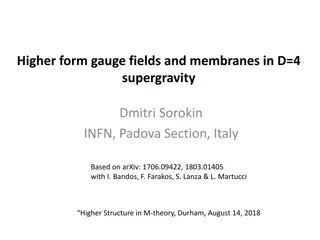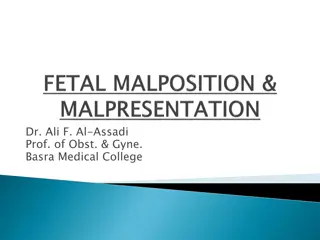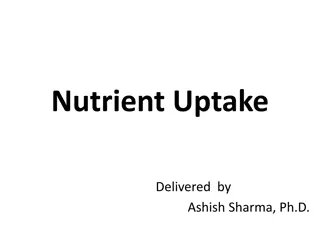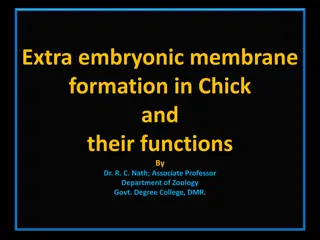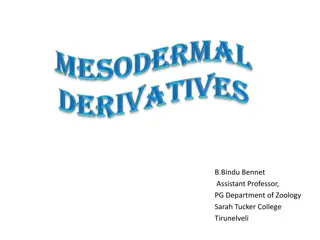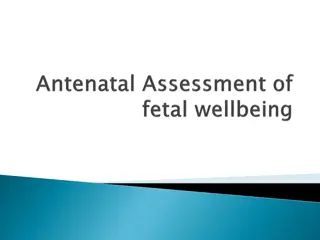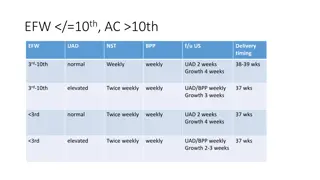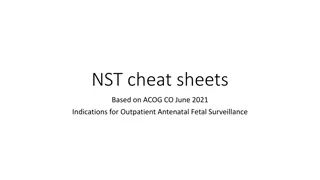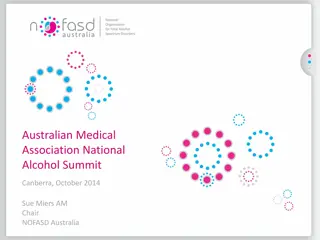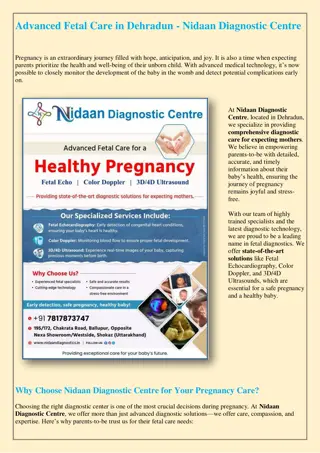Understanding Lipids: Properties, Functions, and Types
Lipids are a diverse group of organic compounds that include fats, oils, hormones, and components of cell membranes. They are vital for energy storage, structural roles in cell membranes, hormone synthesis, and organ protection. Lipids can be classified into different types such as waxes, triglyceri
11 views • 14 slides
Understanding Stillbirth: Causes, Symptoms, and Investigations
Stillbirth, the delivery of a baby with no signs of life after 20 completed weeks of pregnancy, can have profound emotional and social effects. Unexplained causes account for 50% of cases, with fetal, placental, and maternal factors contributing. Risk factors include obesity, maternal age, smoking,
2 views • 26 slides
Maternal and Fetal Complications of Obesity in Pregnancy
Understanding the impact of obesity stigma as a stressor throughout the lifecourse is essential, especially concerning pregnancy. The prevalence of pre-pregnancy overweight and obesity poses significant risks, leading to various maternal complications like gestational diabetes, cesarean delivery, an
0 views • 62 slides
Understanding NGS and Fetal Fraction in Prenatal Screening
Next Generation Sequencing (NGS) plays a key role in prenatal testing by analyzing cell-free DNA (cfDNA) to determine fetal fraction and detect genetic anomalies like Down syndrome. The process involves DNA extraction, library construction, barcode labeling, sample pooling, quantification, and seque
0 views • 13 slides
Understanding Infections through Skin and Mucous Membranes
Infections can be transmitted through skin and mucous membranes via direct or indirect human contact, as well as from non-human sources. The infective agents include viruses, bacteria, fungi, and arthropods. Factors like high population density, poor hygiene, and host behavior play crucial roles in
4 views • 26 slides
Understanding Common Labor Complications and Management Options
Labor and birth processes are typically straightforward, but complications can arise, such as failure to progress, fetal distress, excessive bleeding, malposition, prolapsed umbilical cord, cephalopelvic disproportion, and uterine rupture. Management strategies include rupturing membranes, pain reli
1 views • 24 slides
Understanding Fetal Mummification in Domestic Animals
Failure in pregnancy stages can lead to fetal mummification, characterized by autolytic changes, mummification process, and dry, leathery tissue. Events required for mummification include fetal death post-bone development, rapid resorption of fluids, absence of oxygen and bacteria. This process is c
2 views • 27 slides
Comprehensive Overview of Treatment Membranes in Water Quality Risk Assessment Training
Comprehensive overview of treatment membranes in water quality risk assessment training, covering various membrane types, applications, and considerations. Membranes play a crucial role in removing a range of contaminants from water sources, with different membrane types suited for specific applicat
0 views • 9 slides
Understanding Fetal Movement Counts: Importance, Timing, and Tracking Methods
Fetal movement counts, also known as kick counts, are essential for monitoring your baby's well-being during pregnancy. This article explains the significance of kick counts, when to do them, and how to track fetal movements effectively. Learn why kick counts are crucial, when to start counting, and
0 views • 6 slides
Mechanism of General Anaesthesia Theories: Lipid Solubility, Surface Tension, Microcrystal, Protein Binding
Mechanism of general anaesthesia involves theories focusing on the interaction of anaesthetics with cell membrane components like lipids and proteins. The Lipid Solubility theory emphasizes the importance of an anaesthetic's affinity and solubility in nerve cell membranes, while the Surface Tension
1 views • 10 slides
Understanding the Gibbs-Donnan Effect in Biological Systems
The Gibbs-Donnan Effect, named after physicists Gibbs and Donnan, explains the selective permeability of membranes to ions, leading to the establishment of Donnan potential. This phenomenon affects the distribution of ions and proteins across cell membranes, influencing processes like osmosis and io
0 views • 27 slides
Clinical Diagnosis and Assessment of Pre-Labour Rupture of the Membranes
Pre-Labour Rupture of the Membranes (RROM) is characterized by the leakage of amniotic fluid before the onset of labor, particularly when the gestational age is less than 37 weeks. Clinical diagnosis involves a thorough history evaluation and examination, including sterile speculum examination to co
0 views • 18 slides
Overview of Drugs Acting on Skin & Mucous Membranes
This presentation discusses different classes of drugs that act on the skin and mucous membranes, including emollients, demulcents, adsorbents, protectives, astringents, counterirritants, keratolytics, and skin disinfectants. Emollients soften and moisturize the skin, demulcents soothe irritation in
3 views • 10 slides
Understanding Retention of Fetal Membranes in Veterinary Obstetrics
Retention of fetal membranes, a common issue during the third stage of labor, has significant consequences for animals, especially cattle. Causes include insufficient expulsive efforts and placental issues. The incidence ranges from 6.8% to 50%, often associated with dystocia and twin births. Factor
0 views • 25 slides
Premature Rupture of Membranes: Diagnosis and Management Overview
Premature rupture of membranes (PROM) is a complication in pregnancy where the amniotic sac breaks before labor begins. Risk factors include infections and multiple gestations. Diagnosis involves history, physical examinations, and tests like nitrazine and ferning tests. Management depends on gestat
0 views • 7 slides
Abdominal Examination in Pregnancy: Techniques and Objectives
Examination of the abdomen in pregnancy involves assessing various aspects such as determining gestational age, measuring symphysis-fundus height, evaluating fetal lie and presentation, checking liquor amount, listening to fetal heart sounds, and monitoring fetal movements. The process includes gene
0 views • 38 slides
Overview of Induction of Labour for Obstetric Practice
Induction of labor is the artificial initiation of the labor process before it begins naturally. This procedure is performed in cases such as premature rupture of membranes, prolonged pregnancy, preterm premature rupture of membranes, pre-eclampsia, and maternal medical conditions like diabetes or c
1 views • 30 slides
Engineering a Hydrophilic Coating for Water Filtration Membranes
Explore the process of designing a model with hydrophilic polymers as antifouling coatings for water filtration membranes. Discover how these coatings resist fouling, ensuring clean water for consumption.
1 views • 12 slides
Guidelines for Fetal Blood Sampling by Society for Maternal Fetal Medicine
Review of guidelines by the Society for Maternal Fetal Medicine on indications, risks, and recommendations for fetal blood sampling. Recommendations include using FBS for severe fetal anemia/thrombocytopenia, cautioning against unnecessary invasive testing, counseling patients about potential risks,
3 views • 14 slides
Higher-Form Gauge Fields and Membranes in D=4 Supergravity
This study focuses on higher-form gauge fields and membranes in D=4 supergravity, exploring their role in cosmological constant generation and membrane nucleation. The dynamics of three-form gauge fields, their coupling to gravity and membranes, and implications for cosmological models and supersymm
0 views • 17 slides
Titanium Filtration System Overview
A comprehensive overview of the Titanium Filtration System, highlighting its unique titanium membrane technology, benefits over traditional membranes, and comparison with traditional membranes in terms of temperature resistance, chemical and erosion resistance, service life, and more. The system fea
0 views • 10 slides
Understanding Fetal Malposition and Presentation in Obstetrics
Fetal malposition and malpresentation are important considerations in obstetrics. Malposition involves the fetal head presenting in a non-ideal position, while malpresentation refers to cases where the head is not the presenting part. Detecting these conditions through various signs and examinations
0 views • 16 slides
Understanding Membrane Transport Processes in Plant Cells
Plant cells are separated from the environment by plasma membranes, which facilitate the movement of molecules through passive and active transport mechanisms. Transport proteins play a crucial role in allowing the movement of ions and polar molecules, with channels, carriers, and pumps enhancing so
0 views • 20 slides
Extra Embryonic Membrane Formation in Chick and Their Functions
The development of extra embryonic membranes in chick embryos plays a crucial role in their growth and protection. These membranes, including the amnion and chorion, serve various functions such as providing protection, facilitating gas exchange, and supporting the formation of the placenta. Underst
0 views • 20 slides
Understanding Active Transport of Molecules: Driven by ATP Hydrolysis
Active transport, fueled by ATP hydrolysis, facilitates the movement of molecules against their concentration gradients, essential for processes like ion pumping across membranes. The Na+-K+ pump, a prime example, utilizes ATP to transport Na+ and K+ ions across cellular membranes, maintaining impor
0 views • 23 slides
Development of Extraembryonic Membranes in Frog Embryos
The developmental stages of extraembryonic membranes in frog embryos are visually illustrated in a series of images. These images showcase the intricate processes involved in the formation of structures such as the amnion, chorion, yolk sac, and allantois, leading up to the development of the placen
0 views • 18 slides
Antenatal Assessment for Fetal Health Monitoring
There is a growing focus on antenatal assessment to prevent fetal deaths, with a decline in maternal mortality rates worldwide. The primary goal is to ensure fetal well-being, screen high-risk factors, and detect congenital abnormalities early on. Various tests like Maternal Serum Alpha-Fetoprotein
0 views • 39 slides
Understanding the Structure and Function of Cell Membranes in Biology
Explore the intricate details of cell membranes, focusing on the phospholipid bilayer structure, protein interactions, selective permeability, and various transport mechanisms. Discover how membranes regulate the entry and exit of substances, aid in metabolism, and compartmentalize organelles for ef
0 views • 20 slides
Understanding the Importance of Partograph in Monitoring Labor Progress
Partograph is a crucial tool for healthcare providers to monitor labor progression and ensure the well-being of both mother and baby. This article covers the significance of using a partograph, the frequency of recording parameters during labor, and how to plot and interpret findings for effective d
0 views • 17 slides
Understanding Osmosis in Cell Membranes
This quiz explores the concept of osmosis in cell membranes, focusing on the movement of water into outermost cells of roots by osmosis and its implications on cell sap. It covers topics such as active transport, diffusion, pressure in cell contents, and the role of water movement in maintaining the
0 views • 50 slides
Understanding the Anatomy of the Fetal Skull
The fetal skull is a bony cavity that protects the delicate brain and plays a crucial role in the birthing process. This detailed guide explores the composition of the fetal skull, including the bones, sutures, fontanels, regions, and landmarks. Understanding these aspects is essential for assessing
0 views • 18 slides
Understanding Biomembranes: Composition, Structure, and Functions
Biomembranes, specifically the plasma membrane, play a crucial role in cell function by separating and protecting the cell, facilitating communication with the environment, and regulating transport processes. Composed of lipids, proteins, and carbohydrates, membranes have a fluid mosaic structure wi
0 views • 13 slides
Maternal-Fetal Medicine: Diagnosis & Management of Fetal Growth Restriction
This information provides guidelines for monitoring fetal growth based on estimated fetal weight, abdominal circumference, uterine artery Doppler, non-stress test, and biophysical profile. It outlines strategies for surveillance, including frequency and types of tests based on gestational age and gr
0 views • 5 slides
Antenatal Fetal Surveillance Recommendations Based on ACOG Guidelines June 2021
These cheat sheets outline the indications and recommendations for outpatient antenatal fetal surveillance, including the reasons and frequency for non-stress tests (NST) and biophysical profile (BPP) based on various maternal conditions and fetal considerations. Guidelines are provided for differen
0 views • 4 slides
Understanding Fetal Alcohol Spectrum Disorder (FASD) and Supporting Families
Fetal Alcohol Spectrum Disorder (FASD) poses significant challenges for individuals and families, requiring unique parenting approaches and lifelong support. The National Organisation for Fetal Alcohol Spectrum Disorders (NOFASD) in Australia provides crucial information, support services, and advoc
0 views • 18 slides
Development of Fetal Head and Neck Structures in Week 12
The fetal head and neck structures in week 12 exhibit a complex formation process involving contributions from all three embryonic layers and the neural crest. Neural crest plays a significant role in developing jaw skeletal elements, connective tissues, and tendons. The pharynx, starting at the buc
0 views • 30 slides
Standardizing Fetal Growth Assessment for Improved Patient Care
The SOON Consensus Working Group focuses on conducting large-scale research, quality improvement, and standardizing care in fetal growth assessment. With a mission to address the wide variation among centers, the group aims to enhance patient care by standardizing the measurement and interpretation
0 views • 10 slides
Advanced Fetal Care in dehradun - Nidaan Diagnostic Centre
Nidaan Diagnostic Centre offers advanced fetal care for a healthy pregnancy with services like Fetal Echo, Color Doppler, and 3D\/4D Ultrasound. Led by expert specialists, we ensure early detection, safe results, and compassionate care, providing sta
1 views • 4 slides
Two-Dimensional Mathematical Model of Flows in Thin Film Composite Membranes
This study presents a mathematical model for flows in thin film composite membranes, focusing on the permeation of solvent flux and solute rejection. Assumptions include incompressible fluid, constant diffusion of chemical species, and isothermal conditions. Equations describe water flux, solute flu
0 views • 19 slides
Understanding Sterilization and Disinfection Methods
Sterilization involves killing all microorganisms, including bacterial spores, using physical, chemical, and mechanical methods. Disinfection, on the other hand, focuses on removing microorganisms using disinfectants. Chemical methods like antiseptics and disinfectants play a crucial role in ensurin
0 views • 18 slides




